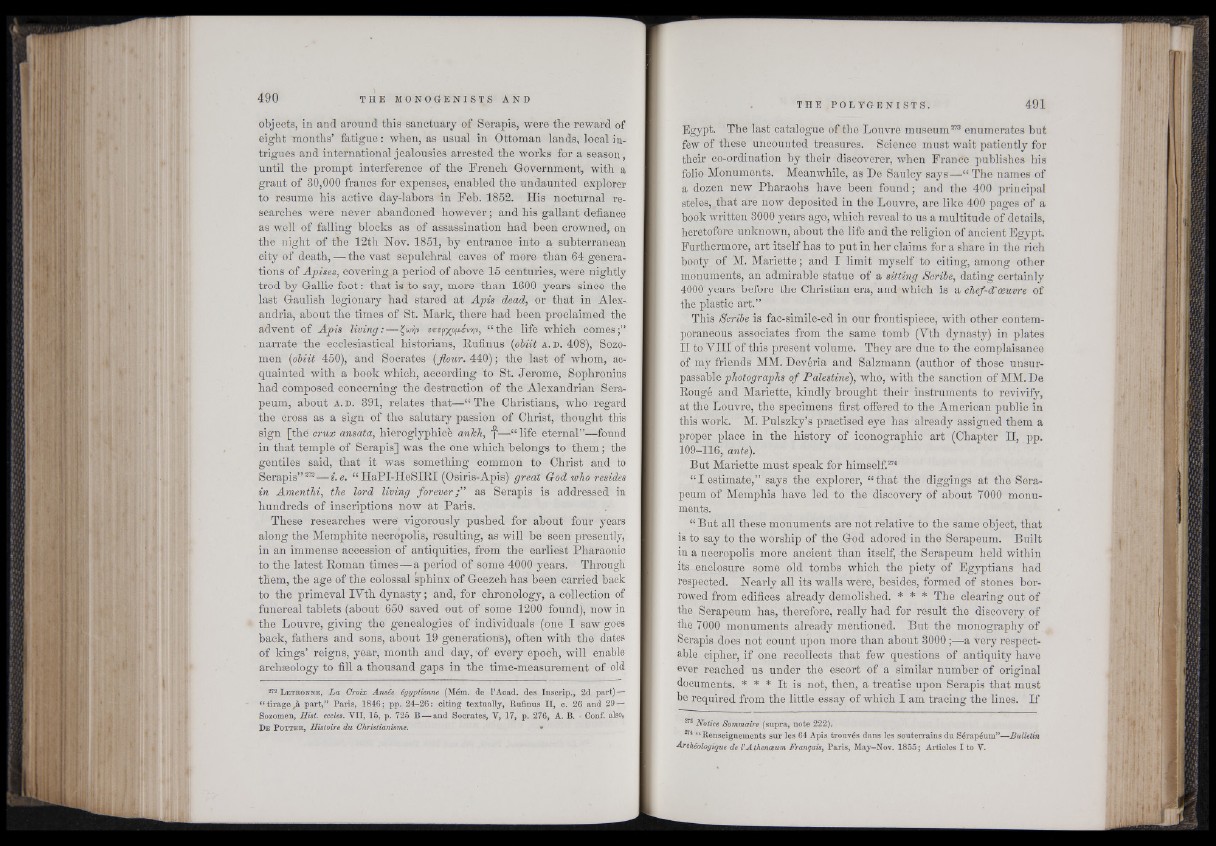
objects, in and around this sanctuary of Serapis, were the reward of
eight months’ fatigue: when, as usual in Ottoman lands, local intrigues
and international jealousies arrested the works for a season,
until the prompt interference of the French Government, with a
grant of 30,000 francs for expenses, enabled the undaunted explorer
to resume his active day-labors in Feb. 1852. His nocturnal researches
were never abandoned however ; and his gallant defiance
as well of falling blocks as of assassination had been crowned, on
the night of the 12th Hov. 1851, by entrance into a subterranean
city of death, — the vast sepulchral caves of more than 64 generations
of Apises, covering a period of above 15 centuries, were nightly
trod by Gallic foot : that is to say, more than 1600 years since the
last Gaulish legionary had stared at Apis dead, or that in Alexandria,
about the times of St. Mark, there had been proclaimed the
advent of Apis living: — “ the life which comes;”
narrate the ecclesiastical historians, Rufinus {ohiit a . d . 408), Sozo-
men (pbiit 450), and Socrates {flour. 440) ; the last of whom, acquainted
with a book which, according to St. Jerome, Sophronius
had composed concerning the destruction of the Alexandrian Sera-
peum, about a . d . 391, relates that-—“ The, Christians, who regard
the cross as a sign of the salutary passion of Christ, thought this
sign [the crux ansata, hieroglyphicè ankh, y—“ life eternal”—found
in that temple of Serapis] was the one which belongs to them ; the
gentiles said, that it was something common to Christ and to
Serapis”272—i.e. “ HaPI-HeSIRI (Osiris-Apis) great God who resides
in Amenthi, the lord living forever;” as Serapis is addressed in
hundreds of inscriptions now at Paris.
These researches were" vigorously pushed for about four years
along the Memphite necropolis, resulting, as will be seen presently,
in an immense accession of antiquities, from the earliest Pharaonic
to the latest Roman times—a period of some 4000 years. Through
them, the age of the colossal sphinx of Geezeh has been carried back
to the primeval IVth dynasty ; and, for chronology, a collection of
funereal tablets (about 650 saved out of some 1200 found), now in
the Louvre, giving the genealogies of individuals (one I saw goes
back, fathers and sons, about 19 generations), often with the dates
of kings’ reigns, year, month and day, of every epoch, will enable
archæology to fill a thousand gaps in the time-measurement of old
272 L e t r o n n e , La Croix Ansêe égyptienne (Mém. de l’Acad. des Inscrip., 2d part) —
“ tirage ,à part,” Paris, 1846; pp. 24-26: citing textually, Rufinus II, c. 26 and 29 —
Sozomen, Hist, eccles. VII, 15, p. 725 B — and Socrates, Y, 17, p. 276, A. B . - Conf. also,
B e P o t t e r , Histoire du Christianisme. »
Egypt. The last catalogue of the Louvre museum273 enumerates but
few of these uncounted treasures. Science must wait patiently for
their co-ordination by their discoverer, when France publishes his
folio Monuments. Meanwhile, as De Saulcy says—“ The names of
a dozen new Pharaohs have been found; and the 400 principal
steles,..that are now deposited in the Louvre, are like 400 pages of a
book written 3000 years ago, which reveal to us a multitude of details,
heretofore unknown, about thé life and the religion of ancient Egypt.
Furthermore, art itsejf has to put in her claims for a share in the rich
booty of M. Mariette; and I limit myself to citing, among other
monuments, an admirable statue of a sitting Scribe, dating certainly
4000 years before the Christian era, and which is a chef-d’oeuvre of
the plastic art.”
This Scribe is fac-simile-ed in our frontispiece, with other contemporaneous
associates from the same tomb (Vth dynasty) in plates
II to VIII of this present volume. They are due to the complaisance
of my friends MM. Devéria and Salzmann (author of those unsurpassable
photographs of Palestine), who, with the sanction of MM. De
Rougé and Mariette, kindly brought their instruments to revivify,
at the Louvre, the specimens first offered to the American public in
this work. M. Pulszky’s practised eye has already assigned them a
proper place in the history of monographic art (Chapter H, pp.
109—116, ante).
But Mariette must speak for himself.274
“ I estimate,” says the explorer, “ that the diggings at the Serapeum
of Memphis have led to the discovery of about 7000 monuments.
“But all these monuments are not relative to the same object, that
is to say to the worship of the God adored in the Serapeum. Built
in a necropolis more ancient than itself, -the Serapeum held within
its enclosure some old tombs which the piety of Egyptians had
respected. Hearly all its walls were, besides, formed of stones borrowed
from edifices already demolished. * * * The clearing out of
the Serapeum has, therefore, really had for result the discovery of
the 7000 monuments already mentioned. But the monography of
Serapis does not count upon more than about 3000 ;—a very respectable
cipher, if one recollects that few questions of antiquity have
ever reached us under the escort of a similar number of original
documents. * * * It is not, then, a treatise upon Serapis that must
be required from the little essay of which I am tracing the lines. If
273 Notice Sommaire (supra, note 222).
274 “ Renseignements sur les 64 Apis trouvés dans les souterrains du Sérapéum”—Bulletin
Archéologique de VAthenæum Français, Paris, May-Nov. 1855; Articles I to V.